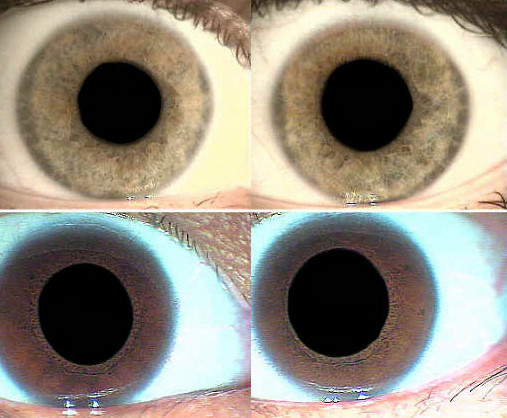Mydriasis, or pupil dilation, occurs when the pupil diameter exceeds 4 mm (more than 33% of the iris diameter) under daylight or artificial light. Several factors can cause this condition:
- Paralysis of the pupil sphincter due to parasympathetic nerve damage (no light reaction; pilocarpine does not affect pupil size).
- Irritation of the sympathetic innervation (spastic mydriasis, where the pupil still reacts to light).
- Dysfunction of the pupil sphincter due to non-functional afferent pupillary neurons, and to a lesser extent, mesencephalic internuncial neurons (pilocarpine causes pupil constriction).
The chronically dilated pupil is influenced by the sympathetic nervous system.

Physiological mydriasis can occur for reasons similar to physiological miosis, including:
- Sexual arousal (differences up to 0.25 mm, more common in people with light-colored eyes).
- Pain (associated with increased adrenaline secretion).
- Emotional responses (pleasure, fear, irritation, anger, increased attention, desire, etc.).
- Vestibular-pupillary reflex (prolonged pupil dilation following minor transient constrictions due to vestibular system irritation).
- Cochleo-pupillary reflex.
- Promortal phase (at the time of death and for the first two to three hours afterward).
Pathological mydriasis can result from various etiological and pathogenetic factors, including:
- Comatose states (thyrotoxic, epileptic, eclamptic, liver-related, hypochlorinemic).
- Endocrinopathies (such as Graves’ disease).
- Severe infections (e.g., botulism).
- Persistent pain syndromes.
- Meningeal irritation (e.g., Flatau’s symptom).
- Visceral diseases with hyperthermia, hypertensive crises, or dyspnea.
- Intoxications (e.g., alcohol, narcotic hallucinogens, carbon disulfide, dinitrophenol).
- Pharmacological effects (e.g., adrenomimetic drugs, anticholinergic agents like novocaine).
- Hysterical episodes (e.g., Raedlich’s symptom).
- Associated conditions such as adrenal exhaustion, urinary tract disorders, bronchial issues, and digestive system dysfunctions.
Unilateral mydriasis is particularly relevant for diagnosing central nervous system disorders and can be part of several syndromes, including those involving the optic nerve, oculomotor nerve paralysis, and various post-traumatic conditions.
Diagnosing unilateral miosis or mydriasis within complex clinical syndromes is generally straightforward. However, differential diagnosis of isolated unilateral mydriasis or miosis can be challenging and may require pharmacological tests with substances like adrenaline or homatropine.
